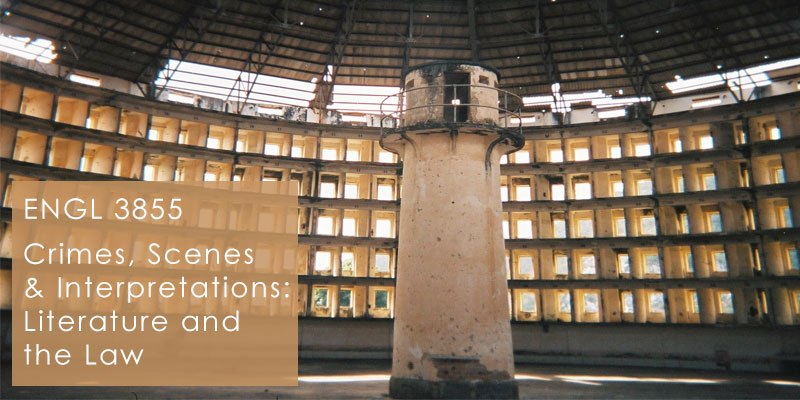Catalog Description: Prerequisites: Completion of Blocks A and B4, an additional course from Block B, and at least one course each from Blocks C and D. Analysis of the relationship between law and literature, including literary depictions of crime and punishment. UD GE C (cl)
Course Description: ENGL 3855 explores the depiction of crime and punishment in literary texts drawn from across historical periods and cultural contexts. Ranging from Dostoevsky’s classic Crime and Punishment, to pulpy detective fiction, to Shakespearean tragedies, to the meditative parables of Kafka, to contemporary nonfiction works such as letters and memoirs by the incarcerated, the history of literature is rich with efforts to use literary technique to frame, debate, and judge the enduring moral questions revolving around crime and the law. The course emphasizes literary texts that explore notions of fairness and justice, and moral codes of right and wrong, the social and economic origins of criminal activity, and the theory and practice of punishment. Pursuing such themes in literature demands not only comparative analysis of different literary traditions and formal conventions, but also an interdisciplinary approach drawing on not just literary criticism but also sociology, psychology, philosophy, and legal studies. The course furthermore demands attention to both the most revered literary texts as well as to “popular” forms such as crime fiction, as well as to film and media studies (where such themes are the bread and butter of no shortage of legal and police procedurals, no less equipped with their own aesthetic conventions and ideological assumptions).
ENGL 3855 is offered in light of new GE requirements that require upper-division general education electives that meet community engagement standards. As defined by the Association of American Colleges and Universities, civic engagement within the academic context involves “working to make a difference in the civic life of our communities and developing the combination of knowledge, skills, values and motivation to make that difference. It means promoting the quality of life in a community, through both political and non-political processes.” This course thoughtfully analyzes and seeks to understand discourses about right and wrong, fairness and justice, crime and punishment, and to explore how those understandings might ramify through the practices of judgment and punishment that structure our neighboring communities and our society as a whole.
Learning Outcomes
Upon completion of the course, students will be able to:
- demonstrate familiarity with primary conventions in literary and cultural representations of crime, punishment, and justice
- recognize the political, psychological, ethical, and ideological stakes of such representations
- assess differences between different genres and forms of writing, as well as between works from different periods and contexts
- apply tools of critical thinking and cultural and literary analysis so as to interpret textual materials from various historical and cultural contexts
- demonstrate the ability to present questions and ideas in both written and verbal form, and to respond to the ideas of others in discussions
Upon completion of the community engagement and civic learning component, students will be able to:
- employ techniques for translating disciplinary knowledge into civic participation and agency within communities
- effectively collaborate with, and communicate to, others as a means of intervening in a civic issue having to do with crime, punishment, and the law
- understand the reciprocal impact of students on their environment and vice versa
Course Outline
The course content will vary depending on faculty interest and expertise. Listed below is one possible course design:
Part I. Law, the Individual, and the Community (Glaspell’s “A Jury of Her Peers,” Melville’s Billy Budd)
Part II. Cinematic Interlude: Hitchcock’s Rope; students begin research for civic learning project on incarceration
Part III. Popular and genre fictions (Poe’s Dupin tales, Doyle’s "Sherlock Holmes," Hammett’s Maltese Falcon)
Part IV. Cinematic Interlude: Noir
Part V. Law AS Literature: Selected cases and their narratives
Part VI. Capital Punishment (Wordsworth, Wright’s Native Son); student presentations on civic learning projects
Part VII. Cinematic Interlude: Von Trier’s Dancer in the Dark
Part VIIII. The Politics and Philosophy of Prison (Foucault, Kafka, The Autobiography of Malcolm X); students submit final “Write for Rights” letters
About the Banner: Interior of Presidio Modelo, Cuba (image from http://en.wikipedia.org/wiki/Panopticon#/media/File:Presidio-modelo2.JPG)
